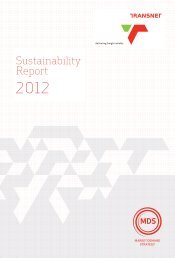Noise and Vibration Report - Transnet
Noise and Vibration Report - Transnet
Noise and Vibration Report - Transnet
- No tags were found...
Create successful ePaper yourself
Turn your PDF publications into a flip-book with our unique Google optimized e-Paper software.
ENVIRO-ACOUSTIC RESEARCHSCOPING NOISE REPORT – TRANSNET: SWAZI RAIL LINK – DAVEL YARD TO NERSTON RSA ROUTE6.3 IMPACT ASSESSMENT CRITERIA6.3.1 Overview: The common characteristicsThe word "noise" is generally used to convey a negative response or attitude to thesound received by a listener. There are four common characteristics of sound, any or allof which determine listener response <strong>and</strong> the subsequent definition of the sound as"noise". These characteristics are:• Intensity• Loudness• Annoyance• OffensivenessOf the four common characteristics of sound, intensity is the only one which is notsubjective <strong>and</strong> can be quantified. Loudness is a subjective measure of the effect soundhas on the human ear. As a quantity it is therefore complicated but has been defined byexperimentation on subjects known to have normal hearing.The annoyance <strong>and</strong> offensive characteristics of noise are also subjective. Whether or nota noise causes annoyance mostly depends upon its reception by an individual, theenvironment in which it is heard, the type of activity <strong>and</strong> mood of the person <strong>and</strong> howacclimatised or familiar that person is to the sound.6.3.2 <strong>Noise</strong> criteria of concernThe criteria used in this report were drawn from the criteria for the description <strong>and</strong>assessment of environmental impacts from the EIA Regulations, published by theDepartment of Environmental Affairs <strong>and</strong> Tourism (April 1998) in terms of the NEMA,SANS 10103 as well as guidelines from the World Health Organization (WHO).There are a number of criteria that are of concern for the assessment of noise impacts.These can be summarised in the following manner:• Increase in noise levels: People or communities often react to an increase in theambient noise level they are used to, which is caused by a new source of noise. Withregards to the <strong>Noise</strong> Control Regulations, an increase of more than 7 dBA isconsidered a disturbing noise. See also Figure 6-2.• Zone Sound Levels: Previously referred as the acceptable rating levels, it setsacceptable noise levels for various areas. See also Table 6.1.• Absolute or total noise levels: Depending on their activities, people generally aretolerant to noise up to a certain absolute level, e.g. 65 dBA. However, anything abovethis level is considered unacceptable.P a g e | 33
















